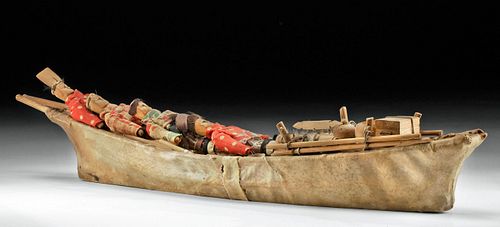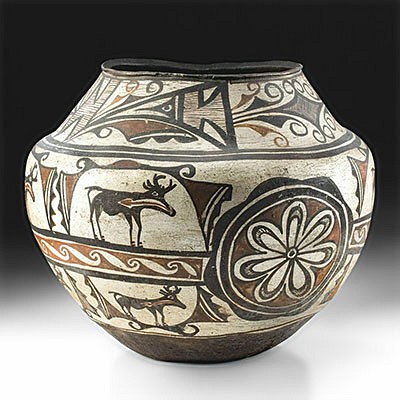1930s Inuit Wood & Hide Umiak, Restored by C. McIntyre
Lot 21
About Seller
Artemis Fine Arts
686 S Taylor Ave, Ste 106
Louisville, CO 80027
United States
Selling antiquities, ancient and ethnographic art online since 1993, Artemis Gallery specializes in Classical Antiquities (Egyptian, Greek, Roman, Near Eastern), Asian, Pre-Columbian, African / Tribal / Oceanographic art. Our extensive inventory includes pottery, stone, metal, wood, glass and textil...Read more
Categories
Estimate:
$2,200 - $3,300
Absentee vs Live bid
Two ways to bid:
- Leave a max absentee bid and the platform will bid on your behalf up to your maximum bid during the live auction.
- Bid live during the auction and your bids will be submitted real-time to the auctioneer.
Bid Increments
| Price | Bid Increment |
|---|---|
| $0 | $25 |
| $300 | $50 |
| $1,000 | $100 |
| $2,000 | $250 |
| $5,000 | $500 |
| $10,000 | $1,000 |
| $20,000 | $2,500 |
| $50,000 | $5,000 |
| $100,000 | $10,000 |
| $200,000 | $20,000 |
About Auction
By Artemis Fine Arts
Nov 18, 2021
Set Reminder
2021-11-18 10:00:00
2021-11-18 10:00:00
America/New_York
Bidsquare
Bidsquare : Art & Artifacts of North America
https://www.bidsquare.com/auctions/artemis-gallery/art-artifacts-of-north-america-7894
Join us for a special auction not to be missed! Collectible Native American art from antiquity to mid-20th century, Spanish Colonial, Latin American, Pre-Columbian, fine & folk art, American frontier items, fossils, and much more! Artemis Fine Arts info@artemisgallery.com
Join us for a special auction not to be missed! Collectible Native American art from antiquity to mid-20th century, Spanish Colonial, Latin American, Pre-Columbian, fine & folk art, American frontier items, fossils, and much more! Artemis Fine Arts info@artemisgallery.com
- Lot Description
Native American, Northwest Coast, Alaska, Inuit / Athabaskan, ca. 1930s CE. A wood, walrus hide, and cloth model of an Athabaskan family in a boat known as an umiak, complete with their possessions. The family of 4 is very detailed, their wooden bodies dressed in cotton clothing that is skillfully sewn into cowl neck shirts and legs with knee high boots decorated with seal fur trim. One retains much of their horsehair coiffure while the others have gone bald in their old age. The prow is laden with their supplies, including a wooden chest, bowls, and rolled hide blankets - the necessary items for a camp. The boat is constructed from a cedar frame then covered with stretched walrus hide. Wooden paddles are lashed next to the figures. This is an intricate model of a group that is presumably on their way to their seasonal camp for fishing and hunting. Size: 21.25" L x 4.5" W x 3.5" H (54 cm x 11.4 cm x 8.9 cm)
The umiak (also umialak, umiaq, umiac, oomiac, oomiak, ongiuk, or anyak) is a type of open-topped, flat-bottomed (no keel) boat used by both Yupik and Inuit and was originally found in all coastal areas from Siberia to Greenland. First arising in Thule times, it has traditionally been used in summer to move people and possessions to seasonal hunting grounds and for hunting whales and walrus. The umiaks were considered the family boat, rowed by women and elders, carrying the provisions, children, dogs, and possessions on journeys, while men traveled in kayaks. Although the umiak was usually propelled by oars or paddles, sails made from seal intestines, or even dog teams pulling the boats from the riverbanks were all used! Models were built to demonstrate their construction to eager European traders who wanted to purchase these lightweight boats, and later as souvenirs or toys.
Chuna McIntyre is a Yupik artist, historian, and dancer. He founded the program and curriculum Nunamfca "of our land" to educate and inspire native and non-native people about Yupik and Inuit traditional culture through storytelling, song, and dance. McIntyre has also consulted with the Metropolitan Museum of Art on the conservation of a Yupik mask made circa 1900 and is a consultant for the Smithsonian Institute for Yupik culture.
For a similar example please see the Dartmouth College Hood Museum of Art website, collection number: 159.9.14387.
Provenance: private Alamo collection, Alamo, California, USA, before 2000
All items legal to buy/sell under U.S. Statute covering cultural patrimony Code 2600, CHAPTER 14, and are guaranteed to be as described or your money back.
A Certificate of Authenticity will accompany all winning bids.
PLEASE NOTE: Due to recent increases of shipments being seized by Australian & German customs (even for items with pre-UNESCO provenance), we will no longer ship most antiquities and ancient Chinese art to Australia & Germany. For categories of items that are acceptable to ship to Australia or Germany, please contact us directly or work with your local customs brokerage firm.
Display stands not described as included/custom in the item description are for photography purposes only and will not be included with the item upon shipping.
#167562Professionally restored by Chuna McIntyre with a patch of hide added near the center of boat running from side to side. Paperboard added to interior to support the figure's feet. Paddles are not original and 2 poles on the prow are not original. Losses to hair on 3 figures. Surface wear as expected with age. Discoloration to cotton clothing. Figures and paddles are secured to the seats by twine.Condition
- Shipping Info
-
All shipping is handled in-house for your convenience. Your invoice from Artemis Gallery will include shipping calculation instructions. If in doubt, please inquire BEFORE bidding for estimated shipping costs for individual items.
-
- Buyer's Premium



 EUR
EUR CAD
CAD AUD
AUD GBP
GBP MXN
MXN HKD
HKD CNY
CNY MYR
MYR SEK
SEK SGD
SGD CHF
CHF THB
THB














